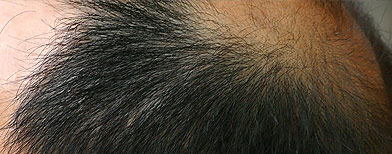
Scientists have discovered a protein linked to male baldness, which could pave the way for new treatments for hair loss in men.
Researchers from the University of Pennsylvania found that men with male pattern baldness have three times more of a protein called prostaglandin D2 (PDG2) in the bald patches of their scalps compared with other parts still with hair.
The protein is thought to work by stopping the growth of hair follicle stem cells in the scalp, responsible for hair growth. This means that treatments to suppress the production of PDG2 could potentially be used to prevent hair loss in men.
Male pattern baldness affects eight out of 10 men under the age of 70, and causes hair follicles to shrink and produce microscopic hairs.
A previous study found that bald areas of the scalp contain the same number of stem cells as normal hair-growing parts of the scalp in the same person, but contain fewer mature cells.
This suggested that the scalp was lacking an activator or something was inhibiting hair follicle stem cells from growing.

In this study, researchers looked at samples of scalp tissue from balding and non-bald spots of more than 20 men with male pattern baldness. Levels of PGD2 were found to be three times higher in the bald patches compared with areas where hair was still growing.
This was also confirmed at the genetic level; PGD2 genes were shown to be more active in bald tissue samples.
When PGD2 was added to hair follicles cultured in the lab, it was "significantly shorter," the study found.
They authors wrote: "Our findings should lead directly to new treatments for the most common cause of hair loss in men.
"The potential for developing these compounds into topical formulations for treating AGA (androgenic alopecia) should elicit great interest moving forward."
The study is published in Science Translational Medicine.
No comments:
Post a Comment